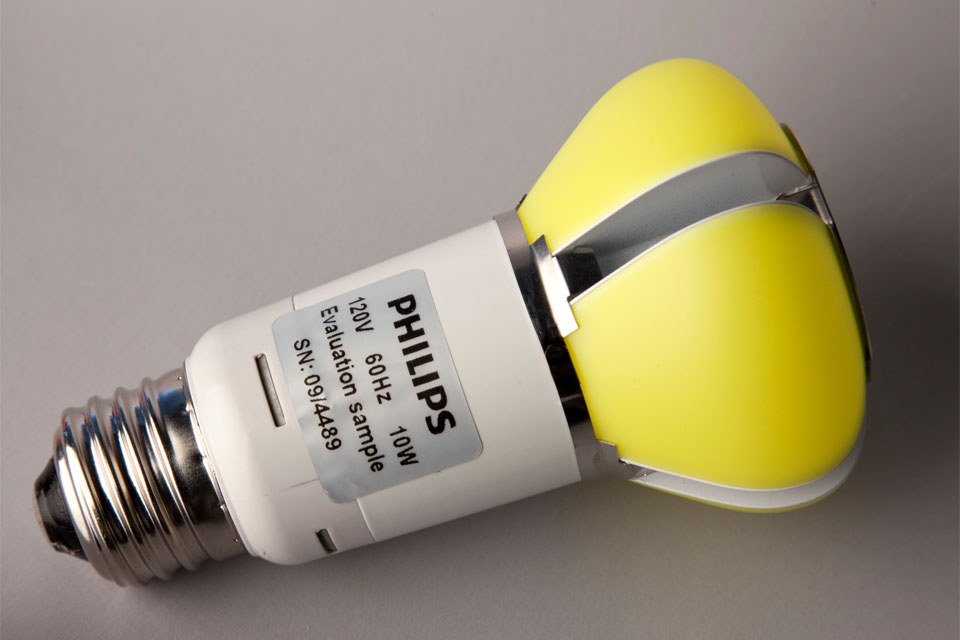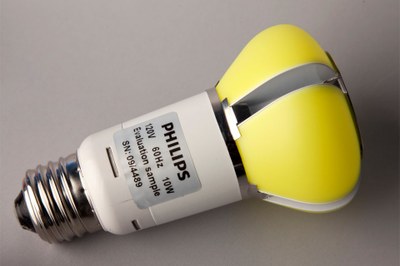Department of Energy Announce Philips as Winner of L Prize Competition
The U.S. Department of Energy today announced that Philips Lighting North America has won the 60-watt replacement bulb category of the Bright Tomorrow Lighting Prize (L Prize) competition. The Department of Energy’s L Prize challenged the lighting industry to develop high performance, energy-saving replacements for conventional light bulbs that will save American consumers and businesses money. If every 60-watt incandescent bulb in the U.S. was replaced with the 10-watt L Prize winner, the nation would save about 35 terawatt-hours of electricity or $3.9 billion in one year and avoid 20 million metric tons of carbon emissions.
Submitted in 2009, the Philips LED bulb successfully completed 18 months of demanding field, lab, and product testing to meet the rigorous requirements of the L Prize competition – ensuring that performance, quality, lifetime, cost, and availability meet expectations for widespread adoption and mass manufacturing.
“The L Prize challenges the best and brightest minds in the U.S. lighting industry to make the technological leaps forward that can greatly reduce the money we spend to light our homes and businesses each year,” said Energy Secretary Steven Chu. “Not only does the L Prize challenge innovative companies like Philips to make LED technology even more energy efficient, it also spurs the lighting industry to make LEDs affordable for American families.”
“We looked at the L Prize challenge as an opportunity to innovate and develop an energy efficient alternative to a product that has remained largely unchanged for over a century,” said Zia Eftekhar, CEO of Philips Lighting North America. “The fact that we are the first and only company capable of submitting a product and completing 18 months of rigorous testing not only underscores our commitment to innovation and quality, it highlights our ability to bring meaningful leading technologies into the mainstream.”
Launched in 2008, the Energy Department’s L Prize competition targets the 60-watt bulb because it is one of the most widely used types of light bulbs by consumers, representing roughly half of the domestic incandescent light bulb market. Innovations in residential and commercial lighting products such as those encouraged by the L Prize expand the lighting choices available to consumers and support the Department’s efforts to reduce our Nation’s energy use, create manufacturing jobs for U.S. workers, and save money for American families and business owners.
The winning Philips product excelled through rigorous short-term and long-term performance testing carried out by independent laboratories and field assessments conducted with utilities and other partners. The product also performed well through a series of stress tests, in which the product was subjected to extreme conditions such as high and low temperatures, humidity, vibration, high and low voltage, and various electrical waveform distortions. The Philips L Prize winning product was also required to have a useful lifetime of more than 25,000 hours, compared with 1,000 to 3,000 hours for the products these highly efficient bulbs are intended to replace. The product uses solid-state lighting technology, which utilizes light-emitting diodes (LEDs) instead of electrical filaments, plasma, or gas, and has the potential to use far less energy than other lighting technologies. As the winner, Philips will receive a $10 million cash prize as well as L Prize partner promotions and incentives. To date, 31 utilities and energy efficiency program partners stand ready to promote and develop markets for the winning product. The L Prize-winning 60-watt equivalent LED bulb from Phillips could arrive in stores as soon as early 2012.
About the "Bright Tomorrow Lighting Prize (L Prize) Decision
Every year it is estimated that more than 425 million 60 Watt incandescent light bulbs are sold in the United States alone, representing approximately 50% of the domestic incandescent light bulb market. The traditional incandescent that has been the market staple for more than a century, but only uses 10% of its energy output for light and wastes the other 90% as heat. The DOE recognized that energy efficient alternatives need to made readily available and become the new standard for Americans.
Why
The US Department of Energy (DOE) established a competition, the Bright Tomorrow Lighting Prize (L Prize) initiative to spur development of high-quality, high-efficiency LED replacements for the common light bulb. Established through the Energy Independence and Security Act of 2007, the L Prize challenged the industry to meet its very demanding requirements – ensuring that performance, quality, lifetime, cost and availability meet expectations for widespread adoption and mass manufacturing.
Who
Philips was the first and only company to officially submit and complete L Prize testing for a 60 Watt equivalent. Since the September 2009 submission, Philips LED has undergone comprehensive evaluation, including performance testing conducted by independent laboratories, field assessments with utilities and other partners, long-term lumen maintenance testing and stress testing under extreme conditions.
How
The Philips L Prize submission required a team of engineers, technology and lighting experts from around the company including Philips Lumileds in San Jose, CA, Philips Color Kinetics in Burlington, MA and Philips Lighting Systems and Controls in Rosemont, IL, working together in multiple locations to push the boundaries of LED technology. As the world’s leading provider of lighting solutions it took Philips several years and millions of dollars in resources to develop the 60 watt equivalent LED that not only met, but exceeded the DOE’s requirements for the L Prize.
The Results
|
|
L Prize Requirement |
Philips Result |
|
Luminous flux (lumens, lm) |
> 900 lm |
910 lm |
|
Wattage (W) |
≤ 10 W |
9.7 W |
|
Efficacy (lm/W) |
> 90 lm/W |
93.4 lm/W |
|
Correlated color temperature (CCT) |
2700 – 3000 K |
2727 K |
|
Color rendering index (CRI) |
> 90 |
93 |
Requirements for the 60 Watt incandescent LED replacement, as laid out by DOE, include:
• Efficacy of more than 90 lumens per watt, exceeding the efficiency of all incandescent and most compact fluorescent sources today, ranging from 10 to 60 lumens per watt
• Energy consumption of less than 10 watts as compared to a 60 Watt incandescent
• Output of more than 900 lumens, equivalent to a 60 Watt incandescent light bulb
• Lifetime of more than 25,000 hours, which is 25X greater than a typical incandescent bulb
• Color Rendering Index (CRI) greater than 90, which is a high measure of lighting quality
• Color Temperature between 2700 – 3000 Kelvin, which is “warm” white light comparable to incandescent
US lighting consumption
According to DOE, an LED replacement for the 60 Watt bulb could save 34 terawatt-hours of electricity per year, enough to power the lights of 17.4 million U.S. households and avoid 5.6 million metric tons of carbon emissions annually.
About Royal Philips Electronics:
Royal Philips Electronics of the Netherlands (NYSE: PHG, AEX: PHI) is a diversified health and well-being company, focused on improving people’s lives through timely innovations. As a world leader in healthcare, lifestyle and lighting, Philips integrates technologies and design into people-centric solutions, based on fundamental customer insights and the brand promise of “sense and simplicity.” Headquartered in the Netherlands, Philips employs over 120,000 employees with sales and services in more than 100 countries worldwide. With sales of EUR 22.3 billion in 2010, the company is a market leader in cardiac care, acute care and home healthcare, energy efficient lighting solutions and new lighting applications, as well as lifestyle products for personal well-being and pleasure with strong leadership positions in male shaving and grooming, portable entertainment and oral healthcare. News from Philips is located at www.philips.com/newscenter.


